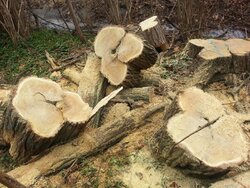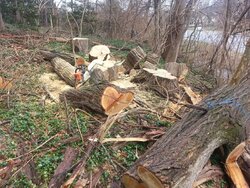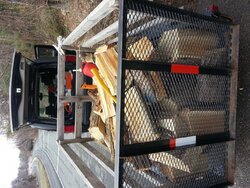honey locust
- Thread starter splitoak
- Start date
-
Active since 1995, Hearth.com is THE place on the internet for free information and advice about wood stoves, pellet stoves and other energy saving equipment.
We strive to provide opinions, articles, discussions and history related to Hearth Products and in a more general sense, energy issues.
We promote the EFFICIENT, RESPONSIBLE, CLEAN and SAFE use of all fuels, whether renewable or fossil.
You are using an out of date browser. It may not display this or other websites correctly.
You should upgrade or use an alternative browser.
You should upgrade or use an alternative browser.
- Status
- Not open for further replies.
Richie
Burning Hunk
The pic kinda makes it look that way...its dosent have green and yellow on the inside. More of a tan heartwood..havent split it yet ....but could be..lol either way good stuff..ill post a better pic of split...
brant2000
Feeling the Heat
I've been curious, is there much difference between the two (black vs. honey). If this is black locust, then I don't think that I've ever come across any honey. This looks exactly like what I'm used to seeing.
Richie
Burning Hunk
Black locust is sweet stuff. This winter I burned 50/50 mix of BL with black birch and oh my gosh. This is the perfect mix for deep winter stuff as the birch burns super super hot and a bit faster. It gets the locust going real good and then the BL takes off from there. It is almost like an afterburner to supercharge the load. This was hands down the perfect mix.
The difference is the color of the heartwood...black is usually green and yellow splits...honey is a salmon colored heartwood..@ least in my experence...the bark on this is heavy like all the BL ive cut but the heartwood is off..
Backwoods Savage
Minister of Fire
Splitoak, if you would like to make a few points with your lady, you have some almost perfect pieces to cut a cookie from and it will be in the shape of a heart. Or you could cut several cookies and make a path with them. Or, you could simply burn them and enjoy the heat but it would be a shame to miss an opportunity with those logs.
Im going to pick them up in a few..lol..prolly close to a full cord in that little area...its some big locust..
PA. Woodsman
Minister of Fire
I burned a few pieces of Honeylocust the last two nights, and I'm sorry to say that I wasn't impressed with it, and yes it was dry, not wet or green. I wouldn't be so much in a hurry to get it if I see it in the future, and I have had the same results in the past with it too. Just not that impressed with it.
And yes, your pictures are Black Locust...
And yes, your pictures are Black Locust...
Osagebndr
Minister of Fire
I burned a few pieces of Honeylocust the last two nights, and I'm sorry to say that I wasn't impressed with it, and yes it was dry, not wet or green. I wouldn't be so much in a hurry to get it if I see it in the future, and I have had the same results in the past with it too. Just not that impressed with it.
And yes, your pictures are Black Locust...
What is it about honey locust that you don't like - doesn't produce heat, hard to work with? Have you burned black locust, and if so did you like it?
PA. Woodsman
Minister of Fire
What is it about honey locust that you don't like - doesn't produce heat, hard to work with? Have you burned black locust, and if so did you like it?
It burned, but it didn't have a lively flame to it like other hardwoods I've got; I felt like I had to add some more wood to it to get it going, and yes it was dry, just never took off. I have burned Black Locust too and have had some over the years that rocked like other fellas on here say but most of that too for me doesn't really burn well, it more like burns slow with a low flame even with the air vents wide open. Maybe it's my draft and set-up but I really don't get excited when I see either of the Locusts-sorry, guys!
But I do remember years ago having some Black Locust that rocked, but not lately, and it is dry "seasoned" with low moisture content. It must not like me!
Applesister
Minister of Fire
Honeylocust and Black Locust arent related to each other. Their common names were adopted during the colonies establishment. Their vernacular names were given to them by immigrants who mistakenly thought they were related to european locust. Something to do with the bean pods.
But the later scientific names allowed for their proper establishment.
The term "locust" is used kind of like "poplar"
But the later scientific names allowed for their proper establishment.
The term "locust" is used kind of like "poplar"
Woody Stover
Minister of Fire
That's just the way it burns. I love it in my cat stoves, where I'm not looking for a pretty fire for a long time. I usually load it in the back on a good coal bed (not raked forward) and put some Cherry or something on the front of the load to kick off the burn. Eventually the BL gets going....and burns a long, long time.It burned, but it didn't have a lively flame to it like other hardwoods I've got; I felt like I had to add some more wood to it to get it going... I have burned Black Locust too and have had some over the years that rocked like other fellas on here say but most of that too for me doesn't really burn well, it more like burns slow with a low flame even with the air vents wide open. Maybe it's my draft and set-up
 A buddy has a dying HL that he's gonna let me have, that will be the first time I've burned HL.
A buddy has a dying HL that he's gonna let me have, that will be the first time I've burned HL.Brewmonster
Burning Hunk
Honeylocust and Black Locust arent related to each other.
Well, sorta. They are both members of the pea (fabaceae) family, but that is a big family with many genera. Pea plants and acacia trees are in that family also, but they don't resemble each other very much.
You are right about the confusion caused by common names. In the taxonomy of animals, they have conventions about the correct common name of any given species. No such luck with plants. Better to risk sounding pretentious and use the scientific binomial to avoid confusion.
I have some honey locust pods in my compost pile and now there are little trees coming up. I'm thinking of replanting them. On the btu scale HL is just a little lower than BL. Anyone burn both, and how do they compare to each other? I've heard say that in a grove of BL if you cut a tree down the roots will sprout more trees. Is this the same for HL?
PA. Woodsman
Minister of Fire
Well, sorta. They are both members of the pea (fabaceae) family, but that is a big family with many genera. Pea plants and acacia trees are in that family also, but they don't resemble each other very much.
You are right about the confusion caused by common names. In the taxonomy of animals, they have conventions about the correct common name of any given species. No such luck with plants. Better to risk sounding pretentious and use the scientific binomial to avoid confusion.
The "National Audubon Society Field Guide to North American Trees" has them and Water locust and a few others listed in the "Legume" family, for what that's worth...
PA. Woodsman
Minister of Fire
Anyone burn both, and how do they compare to each other?
Read posts #14 and #16.
Brewmonster
Burning Hunk
Same thing. When I first learned about plants, it was the "leguminosae" family, then it was changed to "fabaceae." Most family names end in "-aceae" and taxonomists decided that they all should. For the same reason "compositae" become "asteraceae" and "cruciferae" became "brassicaceae."The "National Audubon Society Field Guide to North American Trees" has them and Water locust and a few others listed in the "Legume" family, for what that's worth...
Either way both are near the top of the charts btu wise. Get it dried to 15% internal and it will melt a stove down. It will take at least 2 years in ideal conditions to reach that moisture content. Like Oak, Ironwood it takes quite a while to get the middle of a large split dry.
- Status
- Not open for further replies.
Similar threads
- Replies
- 3
- Views
- 889
- Replies
- 14
- Views
- 1K
- Replies
- 7
- Views
- 1K





